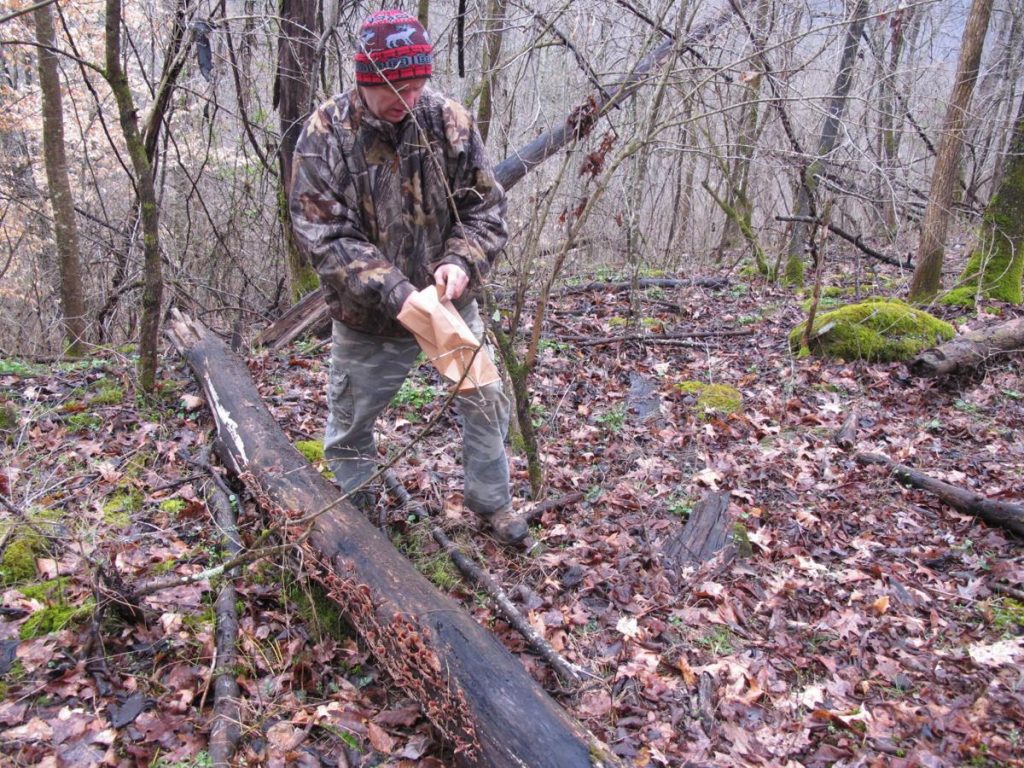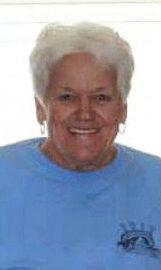The cloudy, April sky promised more rain and it was eerily quiet, just like one of the good parts in a horror movie.
I stood on the porch for half a minute, quietly cursing my GPS and wondering if I’d remembered to bring Brian’s phone number. Then I apologized and went looking for the guy who was supposed to introduce me to chickweed, fiddleheads and daylily roots.
After a month of trying to climb up into the sky, I wanted to spend some time close to the ground. I looked into caving, but a friend who does that kind of thing warned me that this time of the year I might have the same problems with the weather that I’d had with learning about flight.“If you’ve got a lot of rain, we don’t go into the cave,” my friend told me.
The plan just hadn’t come together in time — so, maybe later.
Instead, I hit on foraging, harvesting food from the wild. This would not be hunting, which is an entirely different skill, but collecting roots, leaves and whatever else you can eat.
The idea had first been suggested on a list the West Virginia Division of Tourism provided me after I asked for suggestions about things I might check out around the state.
Foraging had been on the list for April, along with “training and participating in the 32nd Annual Great Greenbrier River Race.”
After a month of eating my feelings, shedding weight and getting in some kind of shape for a triathlon sounded bad. Besides, I didn’t know how the new owners of the newspaper would feel about me submitting a kayak as an expense.
I should maybe start small.
Foraging sounded interesting, particularly since we are headed into the ramp season. People love ramps. Over the next couple of weeks, small church and community groups will be hosting ramp dinners around the state.You’ll see their hand-lettered signs stapled to telephone poles and posted in grocery stores.
I’ve never been to a ramp dinner and, to be honest, really never understood the fuss about ramps.
I’ve only eaten ramps once. I bought them from a food vendor at the state Capitol during the Vandalia Gathering. For a couple of bucks, I got a Styrofoam bowl with an oily potato, a little bit of rubbery egg and a couple of wilted, green strands that were supposed to be ramps.
The only impression it made on me was that it didn’t make an impression.
The texture was a little like an onion. The potato had more flavor. I dumped the bowl and went looking for ice cream.
Spending a month learning about foraging — literally learning about how you might live off the land — sounded like the opportunity to revisit ramps and learn about some of the other wild delicacies I’ve heard mentioned over the years but never tried, like molly moochers (morel mushrooms) and fiddleheads (a kind of fern).
Getting started, however, proved to be a little difficult.
While I was able to round up a list of names, the first few people I emailed didn’t seem all that interested in participating — at least, not in April. My schedule was a little early. A couple of my contacts even suggested I wait until September, when wild food enthusiasts will gather for a weekend at North Bend State Park.
Discouraged, I began to look through the classified section for kayaks. Maybe I could convince the new owners to buy me a used boat.
Then Brian Lucas sent me a list of about 20 items that could be found on his property right now. Brian was willing to show me around, point them out and help me collect them.
I just had to come to him.
Brian lived out in Left Hand, a few miles from Amma, a place I had never heard of, but that my GPS assured me was real.The GPS didn’t get me lost, but the directions overshot the mark.
It took me a while, but I found Brian waiting out in his driveway with a backpack full of plastic bags and a small gardening spade.
I’d driven past him three times before I decided that the guy in camouflage clothing standing near the road holding a shovel wasn’t dangerous.
Before we got started, Brian said he was worried a little about me taking things he said out of context or editing them for effect.
I told him, “I’m just here to learn something. I don’t have an agenda.”
Brian laughed and said he did. People have become so disconnected from their own world.
“The average kid can recognize 1,000 different corporate logos, but they can’t identify 10 plants,” he said. “I think that’s wrong.”
Brian also thought that most Americans have become too accustomed to accepting whatever is on sale at the grocery store as normal and nutritious. He believed the roots, berries and leaves he regularly harvested from his four-acre plot weren’t just novelty foods but were in some ways superior to what was available at Kroger.
Most of it tasted better, once you got used to it.
“And it’s better for you,” Brian said.
He said a lot of supermarket produce has been engineered to make it more durable for transport and storage, and to make it look more attractive to the consumer.
“Grocery store tomatoes don’t ripen on the vine,” he said. “They’re picked green and then gassed with nitrogen, which turns them red.”
This is also why these same tomatoes can be as tender as a tennis ball.
Commercially grown produce also has fewer nutrients, my research showed me. Partly this has to do with genetic modification, but it’s mostly because of soil depletion. Factory farmed vegetables have less vitamins and minerals than they did decades ago because the lands they’re farmed on lost many of their nutrients due to decades of continual use.
Brian said he was a largely self-educated forager, at least in the beginning.
“I started when I was about 8 years old,” he said. “I was curious. I had a grandmother who would tell me what things were — like sour grass. I picked up the rest as I went.”
Now 62, Brian said he’s learned from other foragers, as well as a few survival experts who also have an interest. He’s happy to pass along what he knows, and the wildcraft lore is part of what he teaches at Premium Martial Arts in Dunbar, where he works as an instructor.
Edible plants are all over, Brian said. Most people just don’t know what to look for. Once they’re shown them, they’ll see them all the time, he said.
Of course, there can be some risk, too, particularly for people new to the hobby. Some deadly plants can be confused with the nonlethal variety, and even if a plant doesn’t kill you, it can make you feel like it’s going to.
“And allergies,” Brian acknowledged. “If you have a lot of food allergies to begin with, this might not be a good idea.”
With trying wild food, Brian recommended moderation, trying different items in small amounts and separately, at least at first.
Brian handed me his backpack, picked up his gardening spade and told me to follow him. We walked out to the front end of his property and began.We pulled up dandelion roots and leaves.
“You want the tips of the leaves and not the stems,” he told me.
The leaves could be eaten in a salad or made into a tea. The roots could also be roasted and eaten or used for tea.
Earlier is better for eating the leaves, as they tend to get bitter with age.
Brian pulled up wild garlic, which he said most people think of as wild onions.
“You can use these in soup,” he said. “You just chop up the green parts when they’re small.”
We gathered white clover, yarrow and willow bark, which Brian said had medicinal value.
“Yarrow is good for wounds,” he said. “Willow makes a kind of aspirin. You would boil it to make a tea and then use it if you felt kind of yuck, had a slight headache or something.”
We dug up daylilies and picked off the tiny tubers among the roots.
“You want to wash those,” he said.
Brian recommended treating them like potatoes — boiling them, sauteing them in butter or roasting them — but warned me not to gorge myself.
“They can have a laxative effect,” he said.
We packed everything in separate plastic bags, labeled them and stuffed the bags into the backpack.
Foraging, Brian said, could be a lot like gardening. Good gardeners know what a particular plant or crop needs and where it grows best.
“Ginseng, for example, likes shade and well-drained soil,” he said. “So, you look on the eastern or northern slopes of mountains.”
Brian said ginseng also needs soil with a lot of calcium.
“So, you look for trees like sugar maple. There’s a lot of calcium in the leaves of sugar maples,” he said.
Sympathetic plants will also sometimes grow together, which makes it easier to locate a difficult to find plant, if you know what it will grow next to.
On a certain level, I understood this.
Some gardeners plant beans, squash and corn together. They’re called “the three sisters” because they work well in unison. Squash leaves provide ground cover, which reduces weeds. Beans fix nitrogen in the soil, providing nutrients to the other plants and corn stalks give beans something sturdy to climb.
I tried that once, but the weird, mutant zucchini squash I got from my father just climbed up the corn stalks, pulled them down to the ground and then strangled the bean plants in their sleep.
“With ginseng, you should look for the maiden’s head fern,” Brian told me.
It was also a little early for ginseng.
Brian told me he and his family have been living on the property for about five years. He walked his land often. What was available to harvest changed with the season, and he always carried his cellphone.
Like with every other hobby or interest, there are smartphone apps for foragers. Brian used Forager’s Buddy, which uses GPS to keep track of plants or mushrooms you find and when.
“So, if you find it once, you can find it again,” he said.
After around two hours of stumbling through the mud, picking leaves and digging roots, Brian gave me a bunch of bags full of things to take home and try.
“If you have any questions, give me a call,” he said.
Reach Bill Lynch at lynch@wvgazettemail.com, 304-348-5195 or follow @lostHwys on Twitter. He’s also on Instagram at instagram.com/billiscap/ and read his blog at blogs.wvgazettemail.com/onemonth.

Brian Lucas, a martial arts instructor at Premium Martial Arts in Dunbar, took reporter Bill Lynch out to show him about foraging for wild foods. Brian collected a mushroom he thought might be turkey tail mushroom, which is used in medicinal teas. Before consuming, Brian recommended checking it to be sure. Bill Lynch, Gazette-Mail photo.











